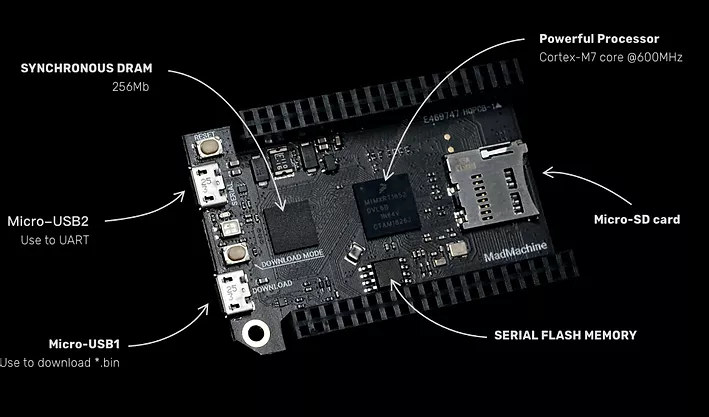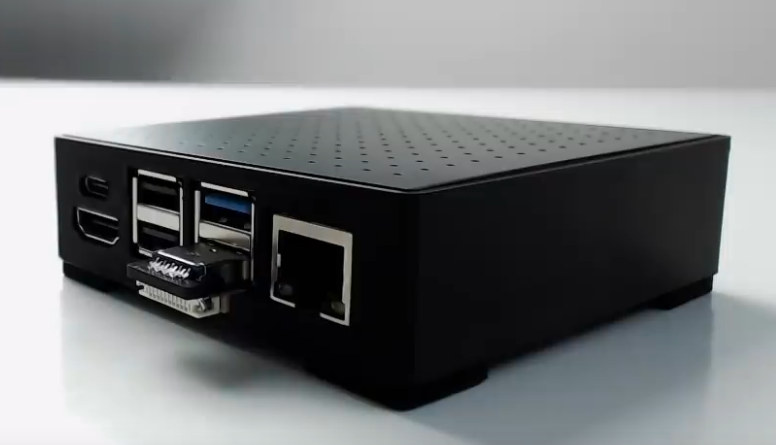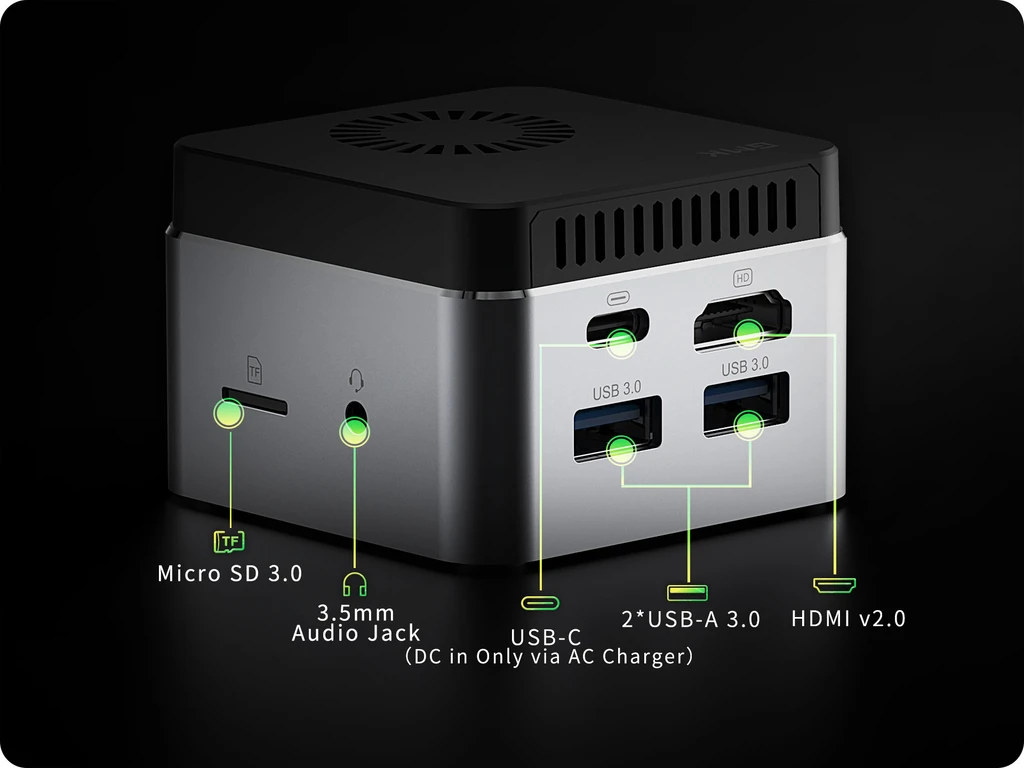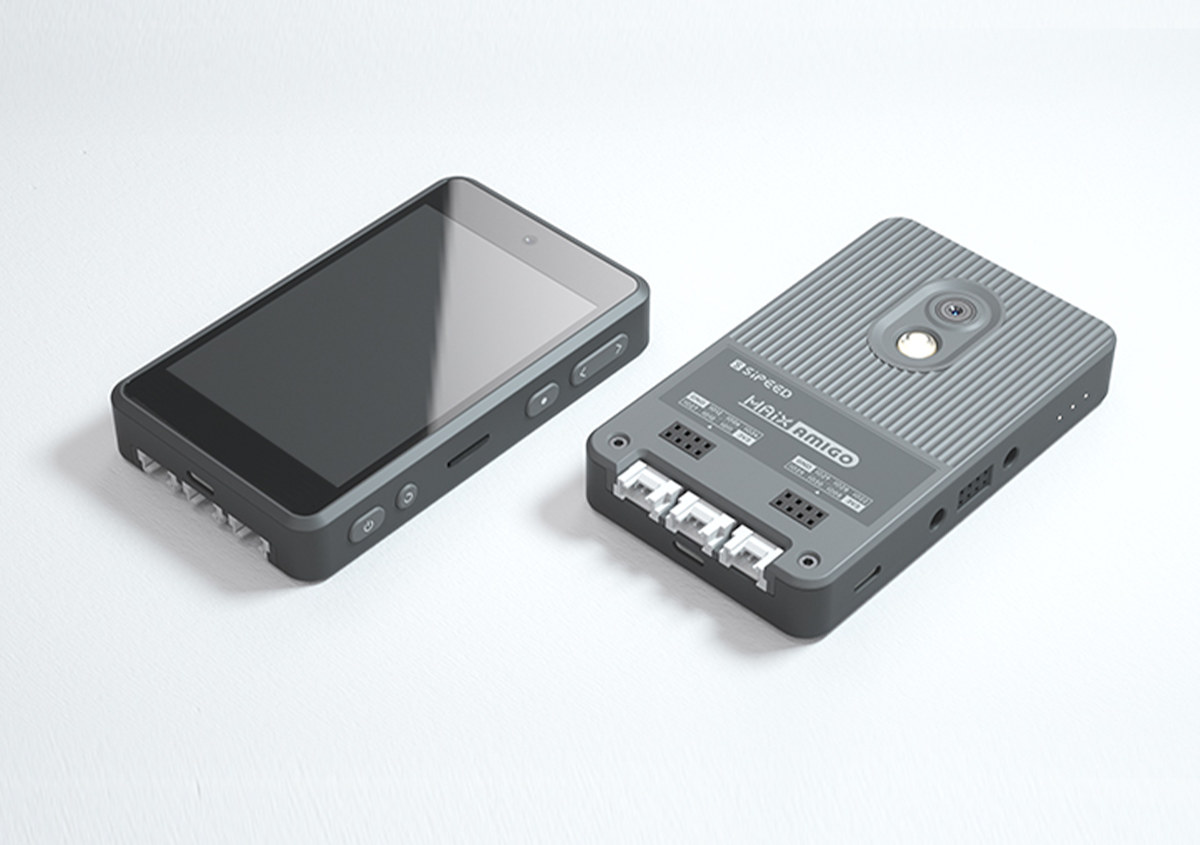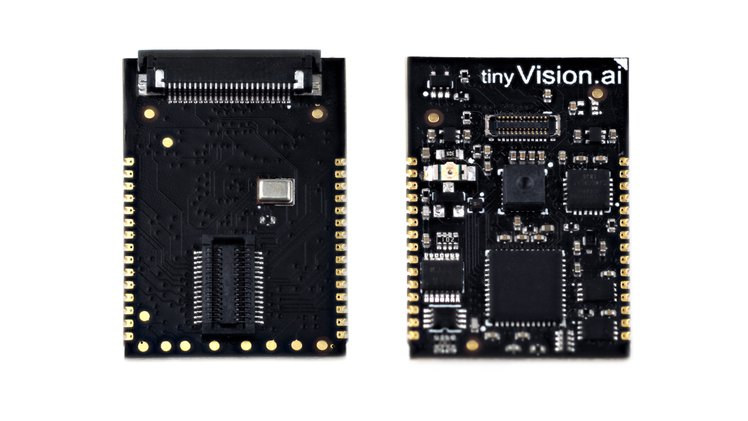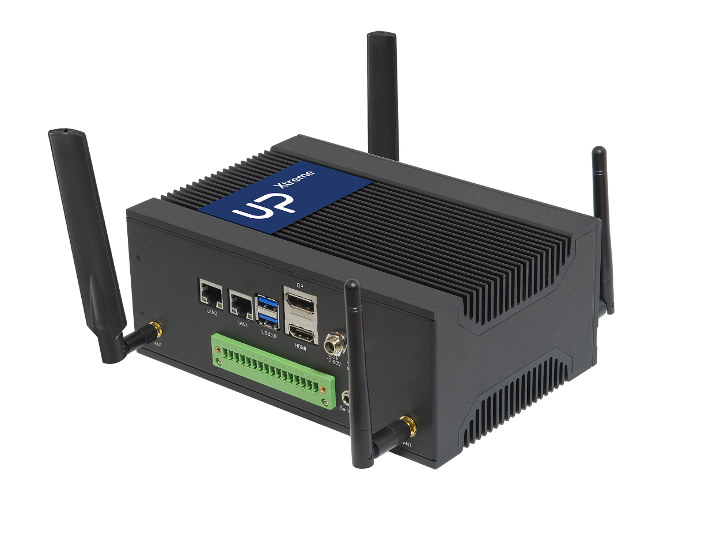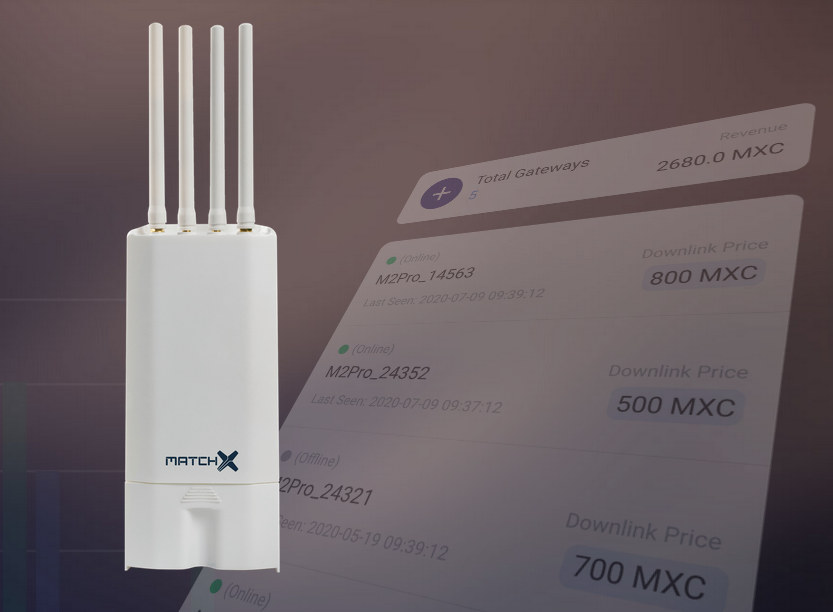Swift programming language has been developed by Apple for iOS, iPadOS, macOS, watchOS, tvOS, and Linux. The programming language works with Apple’s Cocoa and Cocoa Touch frameworks, as well as existing Objective-C code written for Apple products. MadMachine has now created an Arm Cortex-M7 development board, named SwiftIO, specifically designed for Swift programming language through MadMachine IDE and SwiftIO framework. SwiftIO hardware specifications: SoC – NXP i.MX RT1052 Arm Cortex-M7 Crossover Processor @ 600MHz System Memory – 32 MB SRAM Storage – MicroSD card slot supporting standard and high capacity SD cards USB – 1x Micro USB connector for power, 1x Micro USB connector for serial communication Expansion – 2x 46 GPIO headers with 12x 12-bit analog to digital (ADC) converters, 4x UART, 2x CAN, 2x IIC, 2x SPI, 14x PWM Misc – On-board RGB LED, download and reset buttons Power Supply – 5V via Micro USB port Dimensions – […]
NODE Mini Server V3 Transforms Raspberry Pi 4 Into a Server or Mini PC
Hardware hacker NODE has had a busy month starting with the announcement of Zero Terminal V3 modular Raspberry Pi Zero W powered handheld PC, and now he’s just showcased NODE Mini Server V3 that transforms a Raspberry Pi 4 into a compact server or mini PC. The project brings all ports to the same side in a similar fashion as Argon One enclosure through the use of custom adapter boards, but also enable easy integration of USB SSD drives, easier access to the MicroSD card socket, and support for fanless or dual-fan cooling. Besides the Raspberry Pi 4 SBC, NODE Mini Server V3 includes the following components: HDMI Micro HDMI Male Component. “Wedge Type” as this HDMI connector on Aliexpress. HDMI Type A Connector (47151-1001) USB Pololu USB 2.0 Type-C Connector Breakout USB-C Male Plug Breakout Board Male USB 3.0 Plug (692112030100) Female USB 3.0 Connector (48405-0003) Storage USB3 to […]
GMK NucBox Palm-Sized Mini PC Launched on Indiegogo with 8GB RAM, Up to 512GB SSD
Earlier this month, we wrote about GMK mini PC as an alternative to Chuwi LarkBox with a more powerful Intel Celeron J4125 processor coupled with 8GB RAM and 128GB SSD. The tiny computer now has a complete name “GMK NucBox”, and just launched on Indiegogo with rewards starting at $179. GMK NucBox specifications: SoC – Intel Celeron J4125 quad-core Gemini Lake Refresh processor @ 2.0 / 2.7 GHz with Intel UHD Graphics 600; 10W TDP System Memory – 8GB LPDDR4 Storage – 128GB, 256GB or 512GB M.2 2242 SSD, MicroSD card slot Video Output – HDMI 2.0 up to 4K @ 60 Hz Audio – 3.5mm audio jack, digital audio via HDMI Connectivity – Dual-band 802.11 b/g/n/ac WiFi 5 2×2 MIMO up to 867 Mbps and Bluetooth 4.2 USB – 2x USB 3.0 ports, 1x USB Type-C port for power only Misc – Power button, cooling fan with “almost no […]
Puffin Cloud Learning Renders Web Pages Up to 14 Times Faster on Raspberry Pi
The Raspberry Pi is a great little Arm Linux board designed for STEM education. But with many children now have to learn remotely, the board would be useful as a computer replacement, but users may find web browsing on the Raspberry Pi to be rather sluggish. Puffin Cloud Learning is designed just for that use case and promises to make the Raspberry Pi SBC much faster for web browsing, and they tested several websites, and for instance, CNN website loads almost 14 times faster with the Puffin Internet Terminal compared to using Chromium only. How is that possible? Simple: the Raspberry Pi is simply used as a thin client with complex web rendering performed on the company’s encrypted cloud servers where a JavaScript engine is used to pre-process and compress web pages sent to the Raspberry Pi. The company also claims Puffin Internet Terminal is 1200% faster than Chromium using […]
Sipeed Maix Amigo is a Portable 64-bit RISC-V AI Development Kit with Display and Cameras
Earlier this year, Seeed Studio introduced Wio Terminal a portable Arduino devkit with an LCD display, and expansion connectors and headers. The company is now selling a similar looking devkit but for different applications with Sipeed Maix Amigo portable 64-bit RISC-V development kit powered by Kendryte K210 RISC-V AI processor and equipped with an LCD display, two cameras, a few buttons, and several I/O headers and Grove connectors. Sipeed Maix Amigo specifications: SoC – Kendryte K210 Dual-core 64-bit RISC-V (RV64GC) processor with FPU @ 400 MHz (overclockable to 500MHz), 8MB SRAM, built-in AI accelerators for video and audio Storage – 16MB Flash, MicroSD card slot up Display – 3.5-inch TFT capacitive touch screen display with 480×320 resolution Camera VGA front-facing camera up to 30 fps (GC0328 sensor) VGA rear camera up to 60 fps (OV7740 sensor) Audio – Build-in microphone, optional 6-mic array USB – 1x USB Type-C port for […]
Vision FPGA SoM Integrates Audio, Vision and Motion-Sensing with Lattice iCE40 FPGA (Crowdfunding)
tinyVision.ai’s Vision FPGA SoM is a tiny Lattice iCE40 powered FPGA module with integrated vision, audio, and motion-sensing capability with a CMOS image sensor, an I2S MEMS microphone and a 6-axis accelerometer & gyroscope. The module enables low power vision (10-20 mW) for battery-powered applications, can interface via SPI to a host processor as a storage device, comes with open-source toolchain and sample code, and is optimized for volume production. Vision FPGA SoM specifications: FPGA – Lattice iCE40UP5k FPGA with 5K LUT’s, 1 Mb RAM, 8 MAC units Memory – 64 Mbit QSPI SRAM for temporary data Storage – 4 Mbit QSPI Flash for FPGA bitstream/code storage Sensors Himax HM01B0 CMOS image sensor Knowles MEMS I2S microphone, expandable to a stereo configuration with an off-board I2S microphone InvenSense IMU 60289 6-axis Gyro/accelerometer I/Os 4x GPIOs with programmable IO voltage SPI host interface with programmable IO voltage Misc – Tri-color LED, […]
UPX-Edge BrainFrame Edge AI DevKit Targets Smart Video Analytics
AAEON UP Xtreme Edge (UPX-Edge) is a rugged embedded computer built around the company’s UP Xtreme SBC with a choice of 15W Whiskey Lake-U processors ranging from Celeron 4305UE to Core i7-8665UE, and optional Intel Movidius X AI accelerator cards. We previously noted the company had launched UP Xtreme Smart Surveillance kit integrating Milestone video management software (VMS) and SAIMOS video analytics software to the embedded computer. AAEON has now partnered with another company – AOTU.AI – to announce the launch of the BrainFrame Edge AI Developers Kit (DevKit) aiming to help developers and system integrators to rapidly create and deploy Smart Vision applications. The solution relies on UP Xtreme Edge mini PC fitted with an Intel Core i5-8365UE processor and 16GB RAM, 64GB eMMC flash, and two Intel Movidius Myriad X VPUs. We’ve also gone through Up Xtreme Edge specifications, so let’s instead focus on the software. This is […]
MatchX M2 Pro LPWAN Crypto-Miner Supports LoRaWAN and Cryptocurrency Mining
A few years ago, I received MatchX.io MatchBoX outdoor LoRaWAN gateway for review, and eventually tested it with RAK811 LoRa tracker once I got a node to play with, and made sure I did not break any local laws. But now the company has come up with an unusual gateway with its MatchX M2 Pro LPWAN Crypto-Miner that acts as a traditional LoRaWAN gateway, as well as a cryptocurrency miner. I’m a bit perplexed by the solution as miners are notoriously power-hungry, but let’s have a look. MatchX M2 Pro specifications: SoC – NXP i.MX 6UL (MCIMX6G2CVM05AB) single-core Arm Cortex-A7 processor @ up to 528MHz System Memory – 256MB DDR3 RAM Storage – 256MB NAND FLASH, optional SSD up to 32GB or industrial SD-Card Networking & Wireless Connectivity LoRa Radio – SX1302 chipsets, 16 frequency channels Supports EU868, US915, AS920, AS923, AU915, KR920, IN865 regions 2.4Ghz 802.11b/g/n WiFi 4 GPS […]


